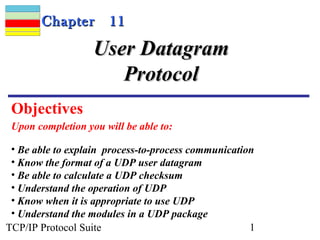
User datagram protocol
- 1. Chapter 11 User Datagram Protocol Objectives Upon completion you will be able to: • Be able to explain process-to-process communication • Know the format of a UDP user datagram • Be able to calculate a UDP checksum • Understand the operation of UDP • Know when it is appropriate to use UDP • Understand the modules in a UDP package TCP/IP Protocol Suite 1
- 2. Figure 11.1 Position of UDP in the TCP/IP protocol suite TCP/IP Protocol Suite 2
- 3. 11.1 PROCESS-TO-PROCESS COMMUNICATION Before we examine UDP, we must first understand host-to-host communication and process-to-process communication and the difference between them. The topics discussed in this section include: Port Numbers Socket Addresses TCP/IP Protocol Suite 3
- 4. Figure 11.2 UDP versus IP TCP/IP Protocol Suite 4
- 5. Figure 11.3 Port numbers TCP/IP Protocol Suite 5
- 6. Figure 11.4 IP addresses versus port numbers TCP/IP Protocol Suite 6
- 7. Figure 11.5 ICANN ranges TCP/IP Protocol Suite 7
- 8. Note: The well-known port numbers are less than 1024. TCP/IP Protocol Suite 8
- 9. Table 11.1 Well-known ports used with UDP TCP/IP Protocol Suite 9
- 10. ExamplE 1 In UNIX, the well-known ports are stored in a file called /etc/services. Each line in this file gives the name of the server and the well-known port number. We can use the grep utility to extract the line corresponding to the desired application. The following shows the port for TFTP. Note TFTP can use port 69 on either UDP or TCP. $ grep tftp /etc/services tftp 69/tcp tftp 69/udp See Next Slide TCP/IP Protocol Suite 10
- 11. ExamplE 1 (ContinuEd) SNMP uses two port numbers (161 and 162), each for a different purpose, as we will see in Chapter 21. $ grep snmp /etc/services snmp 161/tcp #Simple Net Mgmt Proto snmp 161/udp #Simple Net Mgmt Proto snmptrap 162/udp #Traps for SNMP TCP/IP Protocol Suite 11
- 12. Figure 11.6 Socket address TCP/IP Protocol Suite 12
- 13. 11.2 USER DATAGRAM UDP packets are called user datagrams and have a fixed-size header of 8 bytes. TCP/IP Protocol Suite 13
- 14. Figure 11.7 User datagram format TCP/IP Protocol Suite 14
- 15. Note: UDP length = IP length − IP header’s length TCP/IP Protocol Suite 15
- 16. 11.3 CHECKSUM UDP checksum calculation is different from the one for IP and ICMP. Here the checksum includes three sections: a pseudoheader, the UDP header, and the data coming from the application layer. The topics discussed in this section include: Checksum Calculation at Sender Checksum Calculation at Receiver Optional Use of the Checksum TCP/IP Protocol Suite 16
- 17. Figure 11.8 Pseudoheader for checksum calculation TCP/IP Protocol Suite 17
- 18. Figure 11.9 Checksum calculation of a simple UDP user datagram TCP/IP Protocol Suite 18
- 19. 11.4 UDP OPERATION UDP uses concepts common to the transport layer. These concepts will be discussed here briefly, and then expanded in the next chapter on the TCP protocol. The topics discussed in this section include: Connectionless Services Flow and Error Control Encapsulation and Decapsulation Queuing Multiplexing and Demultiplexing TCP/IP Protocol Suite 19
- 20. Figure 11.10 Encapsulation and decapsulation TCP/IP Protocol Suite 20
- 21. Figure 11.11 Queues in UDP TCP/IP Protocol Suite 21
- 22. Figure 11.12 Multiplexing and demultiplexing TCP/IP Protocol Suite 22
- 23. 11.5 USE OF UDP We discuss some uses of the UDP protocol in this section. TCP/IP Protocol Suite 23
- 24. 11.6 UDP PACKAGE To show how UDP handles the sending and receiving of UDP packets, we present a simple version of the UDP package. The UDP package involves five components: a control-block table, input queues, a control-block module, an input module, and an output module. The topics discussed in this section include: Control-Block Table Input Queues Control-Block Module Input Module Output Module TCP/IP Protocol Suite 24
- 25. Figure 11.13 UDP design TCP/IP Protocol Suite 25
- 26. Table 11.2 The control-block table at the beginning of examples TCP/IP Protocol Suite 26
- 27. ExamplE 2 The first activity is the arrival of a user datagram with destination port number 52,012. The input module searches for this port number and finds it. Queue number 38 has been assigned to this port, which means that the port has been previously used. The input module sends the data to queue 38. The control-block table does not change. TCP/IP Protocol Suite 27
- 28. ExamplE 3 After a few seconds, a process starts. It asks the operating system for a port number and is granted port number 52,014. Now the process sends its ID (4,978) and the port number to the control-block module to create an entry in the table. The module takes the first FREE entry and inserts the information received. The module does not allocate a queue at this moment because no user datagrams have arrived for this destination (see Table 11.3). See Next Slide TCP/IP Protocol Suite 28
- 29. Table 11.3 Control-block table after Example 3 TCP/IP Protocol Suite 29
- 30. ExamplE 4 A user datagram now arrives for port 52,011. The input module checks the table and finds that no queue has been allocated for this destination since this is the first time a user datagram has arrived for this destination. The module creates a queue and gives it a number (43). See Table 11.4. See Next Slide TCP/IP Protocol Suite 30
- 31. Table 11.4 Control-block after Example 4 TCP/IP Protocol Suite 31
- 32. ExamplE 5 After a few seconds, a user datagram arrives for port 52,222. The input module checks the table and cannot find an entry for this destination. The user datagram is dropped and a request is made to ICMP to send an “unreachable port” message to the source. TCP/IP Protocol Suite 32
